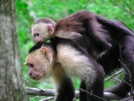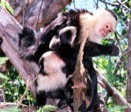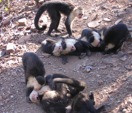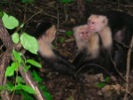








The Database
Researchers study the members of 10 social groups which vary according to size, stability of male membership, and degree of relatedness among individuals. (Click here for more information on the study groups.) All social groups are completely habituated and most have been the subjects of long-term observation. Genealogies, constructed on the basis of behavioral and genetic information, are complete or virtually complete for these groups.
Focal follows
The primary form of data collection, which has remained relatively constant throughout the history of the project, is focal individual follows, in which a team of two observers follows a single individual for a predetermined amount of time (typically ten minutes). During the focal follow, we record all occurrences of social interactions (including gestural, olfactory and vocal communication), manipulations of plants and insects, food processing and ingestion, and interactions with members of other species. Continuous observations are supplemented by instantaneous scans at 2.5-minute intervals, recording the focal monkey’s activity and the proximities of other group members to the focal individual. During focal follows, we also record the activities of all group members within 5 body lengths of the focal, and note whether the focal is visually attending to these behaviors, so that we have a record of learning opportunities for each animal as it develops.
Group scans
We collect group scans every 30 minutes in which we rotate through the group, noting each individual’s activity and the identities of other group members who are within ten body lengths of proximity to the focal individual. These data help us document social networks for those animals who are not our focal subjects. This protocol was established in 2001.
"Ad libitum" sampling
these data are used to note important events that help us monitor changes in social dynamics among the adults: e.g. dominance interactions, coalitions, sex, grooming, and bonding rituals of various kinds.
Fight protocols
We have recently established an elaborate protocol for recording the details of fights, including the roles of all participants, resources at stake, identities of all monkeys in the vicinity who could have participated, and the sequence of events.
Ranging data
Starting in 2010, we began using GPS devices to record the routes the monkeys take each day, and the locations of their sleep sites, intergroup encounters and primary feeding locations.
Food processing protocols
When the animals are foraging on foods that require particularly complex forms of processing, we have a special protocol for capturing the precise motor details of the techniques used for all group members and the extent to which group members monitor one another during these activities. This protocol was established in 2001.
Audio recordings
During some field seasons, we make audio recordings of the monkeys. This can help us document the extent to which there is variability in acoustic structure across study groups, and also determine the degree to which call structure is developmentally flexible.
Video recordings
During some field seasons, we make video recordings, focusing primarily on the details of culturally variable “bonding rituals” such as handsniffing and eyeball-poking that occur in some of our study groups.
Genetic sampling
Since the start of the project, we have collected fecal samples (non-invasively) from all members of our study groups, in order to obtain DNA so that we can determine the parents of each individual.
Hormone sampling
Since 2006, we have collected fecal samples (non-invasively) in order to measure the levels of corticosteroids, testosterone, estrone, and progesterone.
Personality data
Since 2002, experienced field assistants (i.e. those who have been with the project for a year or more) have completed questionnaires on the monkeys’ personality traits.

